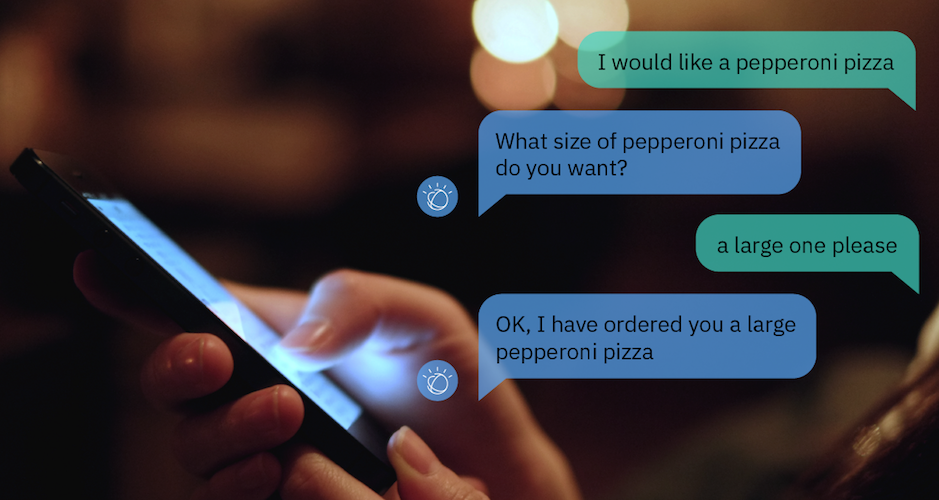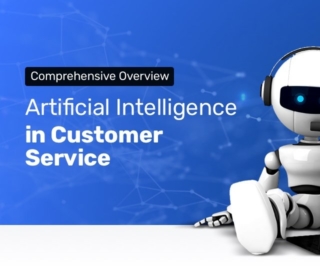
IBM estimates that 265 billion customer support tickets and calls are made globally every year, resulting in $1.3 trillion in customer service costs. IBM also referenced a Chatbots Magazine figure purporting that implementing customer service AI solutions, such as chatbots, into service workflows can reduce a business’ spend on customer service by 30 percent.
We advise that readers take that figure with a grain of salt, considering the source has “chatbots” in its name, but it provides context for what appears to be the most prominent application for AI in customer service.
As of now, numerous companies claim to assist businesses in optimizing their customer support workflows by automating responses to repeat inquiries, such as cancellation or balance requests. They do this mostly by allowing businesses to build their own chatbots or by building chatbots for businesses themselves.
We researched the space to better understand where AI comes into play in the customer service industry and to answer the following questions:
- What types of AI applications are currently in use in customer service? Hint: it’s chatbots.
- What tangible results have been AI driven in customer service?
- Are there any common trends among these innovation efforts? How could these trends affect the future of customer service?
In this article, we’ll highlight four chatbot applications, clustered into the following two categories:
User-Built Chatbots: When a company provides a kit or platform allowing a company to build their own chatbot.
Vendor-Built Chatbots: When a company approaches a vendor with a chatbot goal and the vendor develops an application for them.
With this report, we aim to provide business leaders with an idea of what they can currently expect from AI solutions for customer service. We hope that this research allows business leaders to garner insights they can confidently relay to their executive teams when making informed decisions and thinking about AI adoption in their customer support workflows.
User-Built Chatbots
BotEngine from Livechat
Livechat offers a software called BotEngine, which they claim can help mostly eCommerce businesses answer customer support inquiries that are unique to their business using natural language processing (NLP) and an interface that provides users the ability to build their own chatbots.
Livechat claims users can first select the channel on which they wish to integrate the BotEngine chatbot they intend to create. BotEngine integrates with Facebook Messenger, Slack, Skype and Twitter among others.
It also provides a widget that allows customers to interact with the user-built chatbot on the user’s website itself. The user can then write a series of responses to variations of questions, as well as “Yes” or “No” customer responses. Livechat calls these discussion series “Stories.”
Once a Story is built and implemented, it seems the chatbot is trained by the user to respond to the different variations of the questions. The chatbot also accumulates historical data of numerous Stories and checks that data with each run-through of a Story to provide more accurate responses to the customer’s questions within that Story.
This could come into play especially when the user builds a chatbot that can respond to customer questions and replies with images and video, which the company claims is possible with BotEngine.
BotEngine also provides the number of unique interactions with a given Story in the last seven days to a user on the backend; the company calls this count “metrics.” These metrics could allow companies to know which Stories, which customer inquiries, are most frequent or are becoming more frequent. Livechat also claims BotEngine can send the data it collects to various CRMs for ease of access.
Below is a 4-minute video demonstrating how a BotEngine chatbot is built:
Livechat does not make available any case studies reporting success with their BotEngine software, perhaps due to the hands-off nature of it. Any company can sign up for a BotEngine account starting at $50 a month. Although this access likely comes with customer support, BotEngine does not seem to require a lengthy integration process that would have Livechat staff working with a business to ensure the integration goes smoothly.
In other words, Livechat might have metrics on the number of businesses with BotEngine accounts, but it may not have to build the relationships with businesses that might make asking for a case study easier. We should note that this is speculation.
As such, Livechat doesn’t list any marquee users of its BotEngine platform.
There does not seem to be any C-level executives nor any employees on the team with an AI background. In fact, the Livechat does not seem to have a CTO. Although Livechat is a large company, we caution readers to be wary of companies that claim to do AI without any C-level AI experts on their team.
Dialogflow
Dialogflow, formerly Api.ai and Speaktoit, is another software that offers users the ability to build their own chatbot on the Google Cloud Platform, which they claim can help businesses with complex customer service inquiries and varied ways in which customers can interact with the business more efficiently deal with those inquiries and interactions.
They do this by taking advantage of Google’s historical database using NLP. Dialogflow seems to work with voice commands as well, integrating with Google Home.
Dialogflow claims businesses can build their chatbot by typing the common customer support inquiries they receive and variations of those inquiries into several boxes. Then, Dialogflow claims its software looks for common responses to similar inquiries across Google’s database. The system then provides responses to those customer inquiries based on the responses it finds in Google’s record.
In addition, Dialogflow notes that businesses could further anticipate unique customer responses and train the bot to interpret them as a single point of incoming data that a human would then still be able to use to best serve the customer.
For example, a customer might tell an ice-cream shop’s Dialogflow chatbot that they want to order a chocolate sundae. The shop could program the chatbot to ask what toppings the customer wants on their sundae.
If the customer says “jimmies,” but the ice-cream shop lists that topping as “sprinkles” on their website, the shop could program the chatbot to interpret “jimmies” as sprinkles. The order would then come into the shop as a chocolate sundae with sprinkles.
In a similar vein, Dialogflow claims to have helped Dominos create a chatbot that allows customers to make orders off their online menu. Dominos claims this task was too complex for other chatbot services to handle because customers could theoretically order any combination of items from the menu.
Domino’s resulting chatbot seems to work similarly to the ice-cream shop example below, although Dialogflow provides no statistics for any of their case studies the way Next It did with their case studies.
Dialogflow] also lists Ticketmaster and KLM Royal Dutch Airlines as/some of their past clients.
In the below video, from 7:27 to 16:30, Google employee Priyanka V. demonstrates how to use Dialogflow:
Google acquired Dialogflow in September 2016 for an unspecified amount of money. Software development for Dialogflow is now done by Google software engineers.
Vendor-Built Chatbots
Next IT
Next IT offers conversational AI software which they claim can help businesses of all kinds save on customer service costs using NLP-based chatbots.
Next IT claims their staff first uses “machine learning technologies,” likely an NLP algorithm, to retrieve data from a business’ backlog of conversations between agents and customers. With this information, Next IT then proposes a chatbot that would work best for that business. After approval, Next IT creates the chatbot themselves.
Next IT then seems to train the chatbot on the business’ customer-agent conversation backlog before providing it to the business with whom they are working. The chatbot would then, theoretically, be ready to integrate into the business’ website as soon as Next IT “hands” it to them. By the end of the transaction, the business could have a tailor-made chatbot which is able to answer the most frequently-asked questions it receives.
Below is a 1-minute video demonstrating how a Next IT chatbot might work when the company is finished training it:
Next IT claims to have helped Amtrak create a self-service chatbot that allowed website visitors to more easily purchase ride tickets. Next IT created Julie, an award-winning chatbot designed specifically to handle Amtrak’s customer inquiries.
Prior to being a chatbot, Julie was Amtrak’s automated phone service. According to Next IT, implementing the Julie chatbot resulted in Amtrak saving $1 million in customer support expenses in one year as well as 30 percent more revenue generated per travel booking based on a monthly average.
Next IT also lists the US Army, Alaska airlines, Charter Communications and BECU as some] of their past clients.
Fred Brown is the CEO of Next IT, which was acquired by Verint for $30 million in 2017. He does not list his past education nor work history on his LinkedIn profile, and it appears that Next IT’s CTO Mike Wiseman does not have a LinkedIn profile. That said, Next IT has 138 employees, and its parent company Verint has over 3,000.
Digital Genius
Digital Genius offers a software which they claim can help businesses such as travel agencies both automate their repetitive customer support inquiries and assist human agents with answering customer questions using NLP. Essentially, Digital Genius offers a chatbot that allows for greater user input, a service they call “Co-Pilot.” Digital Genius primarily integrates with Salesforce and Zendesk.
Digital Genius claims their software automatically pulls possible responses to frequent customer inquiries based on a business’ historical record of customer-agent conversations. In other words, the software generates responses to customer questions from past human responses to those questions.
The Digital Genius chatbot can then automatically send that generated response to the customer, or it can also be set to wait to send the response until it receives human approval. This could potentially minimize future errors as each time the human agent approves or disapproves of a response, the chatbot will take that decision into consideration when it offers its next response.
In effect, Digital Genius says the business’ human customer support agents are in part responsible for training the machine learning algorithms behind the chatbot. From our research, we’ve found that this is common for many chatbots on the market.
According to Digital Genius, if the chatbot’s generated response falls above a certain confidence interval of accuracy, provided as a percentage, then the system can be set to automatically send the customer that response.
For example, if a customer asks, “Is the seat next to me still empty,” the chatbot may present the response, “The seat next to you is still available” with a 75-percent confidence interval. That 75 percent figure might warrant human agent approval before the response is sent.
On the other hand, if a customer asks, “Can I bring my puppy on the flight,” the chatbot may generate the response, “Yes, you can bring pets on board in economy and business class” with a 98-percent confidence interval. At a 98-percent confidence interval, the chatbot may automatically send the customer the response.
Confidence seems to be one of Digital Genius’ value propositions. The confidence interval tests the accuracy of the information it is sending to the customer. In the seat availability example, the system determined that there was a 25-percent chance that the customer’s seat was already taken. It would then be up to a human agent to verify if that is actually the case to make sure the customer isn’t misled.
Additionally, Digital Genius claims its chatbot will transfer the customer to a live service agent (on the user business’ staff) if it cannot interpret the customer’s response.
In the below video, from 1:34 to 3:00, Mikhail Naumov, President and Co-Founder of Digital Genius, demonstrates his company’s chatbot:
Digital Genius claims to have helped Travelbird reduce the time its customers spend dealing with customer support representatives. Travelbird integrated Digital Genius into their Zendesk account so that it might handle repetitive customer inquiries. According to Digital Genius, after 3 months their software was helping Travelbird with upwards of 65 percent of its customer service tickets.
Due to the high frequency of use, Digital Genius claims that the chatbot was generating responses with confidence intervals above 95 percent. Travelbird agents, therefore, found themselves using those generated responses—also called, macros—200 percent more often than before they integrated the chatbot into their service protocol.
Digital Genius adds that Travelbird reduced the number of times human agents needed to assess the customer inquiry and type out a response to it. Digital Genius claims this could save the company’s customer support costs.
Nine months after Travebird began using the company’s chatbot, Digital Genius says the business increased the average retention of their support staff from eight to 12 months.
Digital Genius does not list any major companies as clients, but they have raised $26 million in funding.
Bogdan Maksak is Co-Founder and CTO at Digital Genius. He holds a Master’s degree in software engineering from Oxford University. However, Maksak does not seem to have a significant professional background in machine learning.
Concluding Thoughts
Near-Term Impact of Chatbots on Customer Service
As of right now, chatbots seem to be the most common application for AI in the customer service space.
Of all of the companies we covered, Verint’s Next IT and Google’s Dialogflow seem to have the most traction as indicated by companies that acquired them, as well as the marquee companies they claim to have worked with.
That said, the companies seem to differ in their user accessibility. Dialogflow presents itself as a modular platform on which businesses can build chatbots themselves. On the opposite end of the spectrum, Next IT staff seem responsible for building the chatbots they sell to client businesses, interacting with those businesses only to acquire historical data on which Next IT staff will train the chatbot.
BotEngine seemed user-friendly, but it lacked case studies and marquee company usage, likely due to the fact that Livechat is first and foremost a live chat service company that provides businesses access to its human support staff.
Digital Genius is the startup of the bunch. We did not find a significant AI background for any members of their team, and there are no significant Bay Area venture firms backing them.
Takeaway for Business Leaders in Customer Service
Chatbots are becoming more popular and more accessible. With chatbot software that integrates into CRM and customer support software such as Zendesk, customer service AI in the form of chatbots is available to businesses of more varying sizes than other forms of AI.
That said, business leaders should not expect chatbots to completely automate their customer support right away if ever. Aside from Next IT, the services covered in this article in some part require a business’ customer support agents to train the chatbot on whether or not the responses it generates for customers are legitimate and accurate.
Also, cheaper chatbot services will require businesses to build their chatbots from the ground up. In the case of Dialogflow, the chatbot training begins with Google’s database, which could save on integration time, but BotEngine and Digital Genius do not have the benefit of being owned by one of the premiere companies doing AI in the world.
Header image credit: IBM







